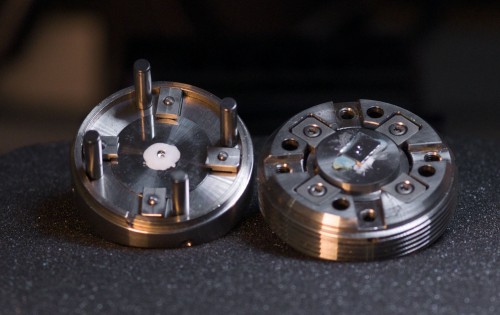
An opened diamond anvil cell. The diamond is visible at the centre of the left disc.
(Courtesy: ESRF/Blascha Faust)
By Ian Randall in New Zealand
We owe our existence to the liquid nature of the Earth’s outer core. Without its internal convection our planet would have no magnetic field to shield us and solar winds would rip away most of our atmosphere. Indeed, this is probably what happened to our neighbour Mars. Despite its importance, however, we don’t know that much about conditions within the core. This is why a recent high-pressure experiment is so important.
Thanks to studies of the travel times of seismic waves through the Earth we do know about the various layers and increasing pressures beneath our feet, but the temperatures of these layers (crucial for understanding convection) remain a hotly contested subject. It’s the usual problem of theoretical models disagreeing with geophysical measurements, compounded by the problem that the pressures found deep within the Earth cannot yet be created in the lab.
Research published today in Science takes the debate a big step forward by predicting an inner/outer core boundary temperature of just under 6000 °C. This is 1000 °C hotter than previously thought.
The research team was led by Agnès Dewaele of France’s CEA national lab and looked at the melting point of small iron samples at a range of temperatures and pressures that might be found inside the Earth. To reproduce such extreme conditions, a diamond anvil cell was used to compress the iron to pressures of millions of atmospheres. Lasers were then used to heat the sample to over 4000 °C. “The iron sample has to be insulated thermally and also must not be allowed to chemically react with its environment,” says Dewael. “Even if a sample reaches the extreme temperatures and pressures at the centre of the Earth, it will only do so for a matter of seconds.” The challenge for the team, thus, was to analyse the iron in this small window of experimental opportunity.
To overcome this difficulty the researchers developed a new, diffraction-based method for scanning their samples, using X-rays from the ESRF synchrotron in Grenoble. With this, they can tell whether it is liquid or solid within one second. This is fast enough to keep the experimental pressure and temperature constant and prevent the sample from reacting with its container. The team measured various melting points of iron up to 2.2 million atmospheres of pressure and 4800 °C. From these, they were able to extrapolate up to 3.3 million atmospheres, which is the pressure found at the border between the liquid outer and solid inner core. This allowed them to predict a boundary temperature of 5956.85 ± 500 °C.
The results of this new study validate current geophysical models of the core/mantle temperature difference. These had stated that the core should be at least 1500 °C hotter than the overlying mantle in order to explain the presence of the Earth’s magnetic field. Based on their observations, the researchers believe the lower experimental results of previous studies may have been thrown off by surface recrystallization of the iron samples.
You can read the paper here.
Very nice work, but with a caution for the results of extrapolition from the measured pressure and temperature values.